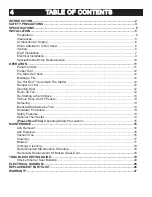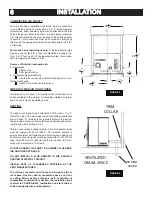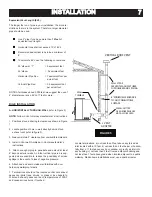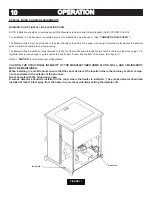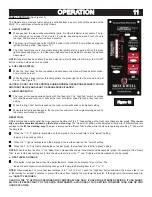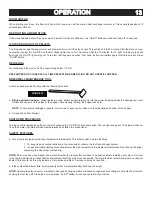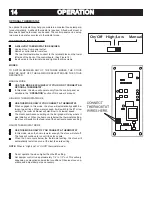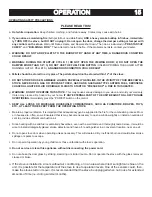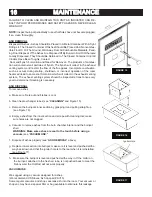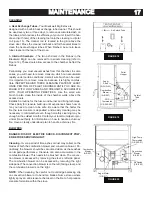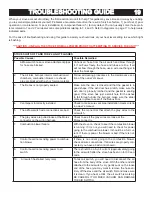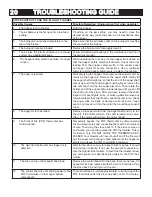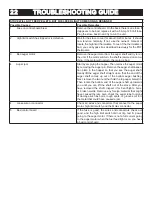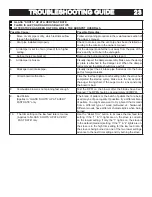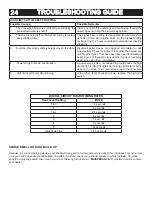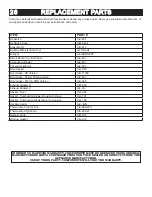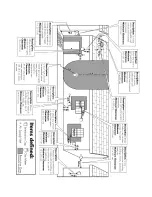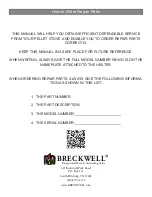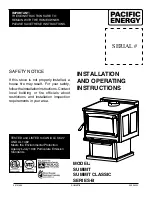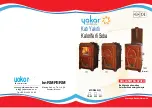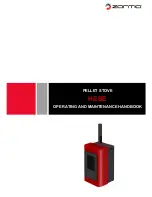
MAINTENANCE
MAINTENANCE
17
17
FIGURE 18
FIGURE 19
FIGURE 20
Air Switch Tube
Pellet
Hopper
Auger
Shaft
(A-AUG-22)
Combustion
Blower
(A-E-027)
POF
Thermodisk
(C-E-090-22C)
Air Inlet
Tube
Air Switch
(C-E-200)
High Temp
Thermodisk
(C-E-090-21)
Convection
Blower
(A-E-033)
Combustion
Blower
(A-E-027)
Auger Motor
(C-E-017)
CLEANING
a.
Heat Exchange Tubes
- Your Breckwell Big E stove is
designed with a built-in heat exchange tube cleaner. This should
be used every two or three days to remove accumulated ash on
the tubes, which reduces the ef
fi
ciency of your unit. Insert the han-
dle end (with hole) of the cleaning tool onto the cleaning rod (refer
to Figure 15). The cleaner rod is located in the grill above the
stove door. Move the cleaner rod back and forth several times to
clean the heat exchanger tubes. When
fi
nished, be sure to leave
tube cleaner at the rear of the stove.
b.
Interior Chambers
- The two ash doors in the
fi
rebox in the
Breckwell Big E can be removed for periodic cleaning (refer to
Figure 18). These doors allow access to the chamber behind the
fi
rebox.
Periodically, you must vacuum ashes from this chamber. In some
cases, you will need to remove creosote, which can accumulate
rapidly under certain conditions. A small wire brush can be used.
It is important to remove creosote because it is highly combus-
tible. INSPECT BEHIND THESE CLEANING PLATES AT LEAST
ONCE PER TON OF PELLETS BURNED UNTIL YOU ARE FA-
MILIAR WITH HOW ASHES AND CREOSOTE ACCUMULATE
WITH YOUR OPERATING PRACTICES. Use the small wire
brush to also clean the inside of the chamber walls, above the
access doors.
Establish a routine for the fuel, wood burner and
fi
ring technique.
Check daily for creosote build-up until experience shows how of-
ten you need to clean to be safe. Be aware that the hotter the
fi
re the less creosote is deposited, and weekly cleaning may be
necessary in mild weather even though monthly cleaning may be
enough in the coldest months. Contact your local municipal or pro-
vincial
fi
re authority for information on how to handle a chimney
fi
re. Have a clearly understood plan to handle a chimney
fi
re.
BLOWERS
DANGER: RISK OF ELECTRIC SHOCK. DISCONNECT POW-
ER BEFORE SERVICING UNIT.
Cleaning
- Over a period of time, ashes or dust may collect on the
blades of both the combustion blower and convection blower. Pe-
riodically, the blowers should be vacuumed clean, as these ashes
can impede performance. Creosote can also accumulate in the
combustion blower. This needs to be brushed clean. The convec-
tion blower is accessed by removing the stove’s left side panel.
The combustion blower can be accessed by removing the right
side panel. The convection blower is on the left (facing stove), and
the combustion blower is on the right.
NOTE:
When cleaning, be careful not to dislodge balancing clip
on convection blower or to bend fan blades. Some stove owners
lightly spray an anti-creosote chemical on the
fi
re to help reduce
creosote formation within the stove.
Summary of Contents for The Big E
Page 25: ...ELECTRICAL DIAGRAM ELECTRICAL DIAGRAM 25 25 FIGURE 21 ...
Page 27: ...27 27 ...


